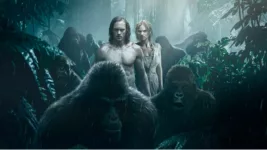Tarzan has been dusted off, his abs polished, and his vocabulary spruced up in David Yates’ handsome but altogether pointless The Legend of Tarzan – a chest-thumping resurrection of the Ape Man that fails to find any reason for the iconic character’s continued evolution.
On the one hand, it’s easy to see why Tarzan has yet again swung back into our lives: Tarzan and Hollywood were born almost simultaneously, like conjoined twins of a new pop-culture machine. The first “Tarzan” silent came out just a few years after Edgar Rice Burroughs’ initial novel.
More than 50 films have followed. But as time has gone on, Tarzan has ceded his mass-market turf to a new set of brawny, questionably attired do-gooders, who swing not from vines but from webs and grappling hooks. Monkey Men are out; Batmen are in.

A still from the movie. (Photo Courtesy:legendoftarzan.com)
Tarzan’s relevance has also drifted. He was originally conceived as a pulpy fable for a society feeling nostalgic for nature as it watched Model Ts roll off assembly lines. Burroughs’ tale coincided with the National Parks movement and the creation of the Boy Scouts.
So if properly outfitted for today’s back-to-the-land trends, Tarzan probably should be a thinner, bearded man who can brew a hoppy IPA and lives off-the-grid in Brooklyn coffee shops.
Can such a vestige of imperial-era imaginations — one dreamed up by a man who never set foot in Africa — be updated to today? The Legend of Tarzan suggests not, and the film’s main source of suspense is watching it twist and contort a century-old property into something meaningful.
Craig Brewer and Adam Cozad’s script sets the tale a decade after the discovery of Tarzan in West Africa; seen only in flashback is Tarzan’s origin story, including a more violent version of his famously loquacious introduction to Jane.
Tarzan or John Clayton III (Alexander Skarsgard) is living in London with his wife, Jane (Margot Robbie). The jungle is far behind him: he’s a Lord, polished and serious but still with ape-like hands that would impress even Donald Trump.

A still from the movie. (Photo Courtesy: legendoftarzan.com)
He’s coaxed back to Africa by George Washington Williams (Samuel L Jackson), an American and veteran of the Civil War who seeks to uncover what he believes is Belgium’s introduction of slavery to the Congo.
The character, loosely based on a real historical figure, is the most intriguing, if awkward, addition. A better, more realistic movie could have been made about him.
In the Congo is Belgium’s envoy, Capt Leon Rom, a linen-suited hunter of diamonds to fill Leopold’s coffers. For this symbol of refinement and menace, the filmmakers naturally turn to Christoph Waltz.
The simplistic historical backdrop of late 19th century Congo here is more cartoonish than even Tarzan himself. But the atmosphere is richly exotic, full of majestic vistas and vivid close-ups. Filming largely on sound stages, Yates, veteran of later Harry Potter films, has firm control of the film’s lushly romantic imagery. You feel that Bogie and Bacall could drift down the river at any moment.
But the film, searching for a purpose and some drama, doesn’t deserve the grandeur Yates gives it. Tarzan, played with sufficient muscle and smarts by Skarsgard, leads an uprising through his ability to communicate with animals and the (largely faceless) natives.
He’s a Jungle Jesus returned to fight colonial incursion, and among the more ridiculous white saviours you’re likely to see.
The wildlife is also comically over-simulated. The CGI gorillas appear like Thanksgiving Day Parade balloons on steroids. Effort has been made to make Jane more than a damsel in distress, which she literally denies being at one point. The scene-stealing Robbie breaks though the role’s stereotypes even while being mired in them.
Agility is the prime trait of Tarzan, but Legend has little of it. The film strains to juggle the character’s baggage instead of embracing the tale’s innate silliness and spirit of adventure (over the years Tarzan has fought dinosaurs and Roman gladiators).
That this is merely another naked attempt to profit from a well-known property is visible even in the film’s title. There, not even hidden by a loin cloth, is a little trademark symbol next to “Tarzan”: King of the Franchise.
The Legend of Tarzan, a Warner Bros. release, is rated PG-13 by the Motion Picture Association of America for “sequences of action and violence, some sensuality and brief rude dialogue.”
Running time: 102 minutes.
Two stars out of four.
(This review has been published in arrangement with AP, Jake Coyle is an AP film review writer)








